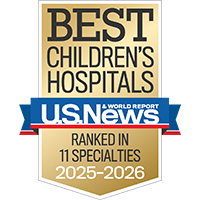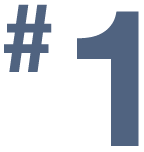Feeling at home
From bedside bingo to therapy dogs, we're here to help kids smile and feel more like themselves.
Visit Child Life services

Sacrococcygeal teratoma (SCT) is an unusual tumor, occurring in about 1 in 40,000 live births. The tumor is located at the base of the tailbone, called the coccyx. This birth defect is more common in girls than in males. Although the tumors can grow very large, they are usually not malignant (cancerous). They can usually be cured with surgery after birth, but occasionally cause trouble before birth.
SCT is typically discovered when a prenatal blood test at week 16 of pregnancy shows a high alpha fetoprotein (AFP) level, or when an ultrasound is performed because the uterus is abnormally large. The increased size of the uterus is often caused by extra amniotic fluid, called polyhydramnios.
Most newborns with SCT survive and do well with surgical removal of the tumor after birth. Malignant tumors are unusual. Rarely, fetuses with very large SCTs develop heart failure. These babies may be candidates for fetal intervention.
Sacrococcygeal teratomas are generally not cancerous, and most babies do well with surgical treatment after birth. Babies with small tumors that can be removed along with the coccyx bone after birth can be expected to live normal lives. However, they will need to be delivered in a hospital with pediatric surgeons and a specialized nursery.
Fetuses with larger tumors or tumors that go up inside the baby's abdomen will require more complex surgery after birth, but generally do well. Very large tumors, which can reach the size of the fetus, can pose a difficult problem both before and after birth.
We have found that SCTs that are largely cystic — meaning filled with fluid — generally don't cause a problem. However, SCTs that are made up of mostly solid tissue and have a lot of blood flow can have adverse effects. This is because the fetus's heart has to pump blood to circulate not only to its body, but also to all the blood vessels of the tumor, which can be as big as the fetus. In essence, the heart is performing twice its normal amount of work.
Fetal echocardiography can be used to measure how hard the heart is working. If heart failure does develop — usually in cases with solid, rapidly growing tumors — the fetus usually will not survive without immediate intervention before birth.
Fetuses with large tumors that have a great deal of blood flow must be followed closely to watch for the development of heart failure, which can lead to fetal death. Even if heart failure does not develop, these babies may require caesarian section delivery and an extensive operation after birth. Most babies will do well once the tumor is completely removed.
The surgery can have long-term consequences, including the reoccurrence of the tumor or difficulty with urination. The child should undergo yearly blood tests for elevated alpha feto-protein (AFP) levels, and should be followed by an oncologist (cancer specialist) and pediatric surgeon in early childhood.
In cases of extreme fetal hydrops, the mother may be at risk for maternal mirror syndrome, which is when the mother's condition mimics that of the sick fetus. The mother may develop symptoms similar to pre-eclampsia, such as vomiting, hypertension, swollen feet and hands, proteinuria (protein in the urine) and fluid in the lungs. Maternal mirror syndrome may occur even if the SCT is surgically removed in utero.
SCT can be diagnosed with an ultrasound examination.
The severity of a sacrococcygeal teratoma is directly related to the size of the tumor and the amount of blood flow to it. Both the size and the blood flow can be accurately assessed with ultrasound and echocardiography.
Because all sacrococcygeal teratomas must be surgically removed after birth, arrangements should be made for the infant to be born in a specialized hospital with pediatric surgery expertise.
Small or medium-sized tumors without excessive blood flow should be followed with regular ultrasounds to make sure the tumor doesn't grow and its blood flow doesn't increase.
Fetuses with large, mostly solid tumors need to be monitored frequently between 18 and 28 weeks of pregnancy for rapid growth of the tumor, the development of excessive blood flow to the tumor, and heart failure. A small number of these fetuses develop heart failure due to extremely high blood flow through the tumor. These fetuses may be candidates for fetal intervention.
Fetal intervention is offered only if there is evidence of heart failure in the fetus. Heart failure is usually diagnosed by ultrasound.
Fetuses who develop evidence of heart failure (hydrops) require fetal intervention. If it is late enough in the pregnancy — past 32 weeks — the baby may be delivered for intensive management after birth. Before that, fetal intervention may be advised to reverse the otherwise fatal heart failure. Open fetal surgery is performed, in which the SCT is removed. This procedure was developed at the UCSF Fetal Treatment Center, and has proven successful in a number of cases.
As with all fetal interventions, at UCSF we have tried to develop minimally invasive methods that don't require opening the uterus — in this case, cutting off blood flow to the tumor instead.
In one method, instead of surgically opening the uterus and removing the tumor, a needle is inserted through the mother's abdomen and uterine wall and into the blood vessels that feed the tumor. Radiofrequency waves are then used to destroy the blood vessels. Without blood flow, the tumor does not grow and the heart failure is reversed. However, damage caused by the probe itself may be difficult to control.
Another method for cutting off blood flow to the tumor is the injection of drugs, such as alcohol, that cause blood to clot.
None of these methods has so far proven effective in all cases.
Women who have fetuses with advanced hydrops and placetomegaly (slightly thickened placenta), or who have maternal pre-eclampsia, are not candidates for fetal intervention, as we have found that these symptoms indicate an irreversible situation.
All babies with sacrococcygeal teratoma should be delivered at a specialized hospital with pediatric surgery expertise. Tumors larger than 10 centimeters in diameter will require a caesarean delivery. The neonatologist (pediatrician specializing in the care of newborns) will provide support in the intensive care nursery until the baby is stable enough for surgery.
Surgical removal of small tumors is straightforward, but removal of large tumors can be very difficult and dangerous. The baby may require blood transfusions and intensive support for days or weeks after surgery. Most will get through this difficult period and enjoy a normal life.
At UCSF, it is our practice to follow children who have had an SCT closely. Children should have yearly blood tests for elevated alpha feto-protein (AFP) levels, which can signal recurrence of the tumor and, possibly, a malignancy. We also recommend follow-up with an oncologist (cancer specialist) and a pediatric surgeon.
If the tumor is quite large and the surgeon performs an extensive complicated removal, there is an increased likelihood of long-term issues. A few babies may have difficulty with urination or bowel movements.
UCSF Benioff Children's Hospitals medical specialists have reviewed this information. It is for educational purposes only and is not intended to replace the advice of your child's doctor or other health care provider. We encourage you to discuss any questions or concerns you may have with your child's provider.

Ranked among the nation's best in 11 specialties

successful open fetal surgery in the world

in number of fetal surgery clinical trials
Feeling at home
